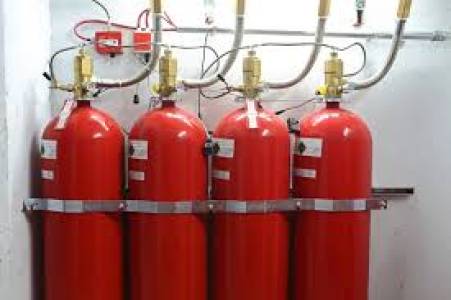Description
ression systems offer a clean, effective, and environmentally friendly solution for protecting valuable equipment and infrastructure from fire damage. Unlike traditional water or chemical systems, gas suppression systems leave behind minimal residue, ensuring minimal disruption to operations after a fire event. They are ideal for applications where water damage is unacceptable, such as data centers, server rooms, museums, and clean manufacturing environments.
How They Work:
Gas based systems utilize inert or extinguishing gases, such as Argonite, Inergen, FM-200 (no longer manufactured), and FE-13 (no longer manufactured), to rapidly extinguish fires by displacing oxygen or interrupting the chemical chain reaction of combustion. These gases are released into a protected area upon fire detection, suppressing the flames quickly and efficiently. The system automatically activates based on pre-determined triggers, such as heat detectors, flame detectors, or smoke detectors.
Key Benefits:
- Clean Agent Suppression: Leaves no residue or damage to sensitive equipment, minimizing downtime and costly cleanup.
- Environmental Friendliness: Many modern gas agents have minimal global warming potential and zero ozone depletion potential, unlike halon-based alternatives.
- Fast & Effective Suppression: Quickly extinguishes fires, limiting damage and protecting lives.
- Versatile Protection: Suitable for various applications, including:
- Data Centers & Server Rooms: Protecting valuable IT infrastructure from fire damage.
- Museums & Archives: Preserving irreplaceable artifacts and documents.
- Clean Manufacturing Environments: Maintaining product purity and preventing equipment damage.
- Telecommunications Facilities: Ensuring network uptime and reliability.
- Industrial Control Rooms: Protecting critical infrastructure and operational control systems.
- Minimal Downtime: Rapid suppression and minimal residue contribute to shorter recovery times.
- Customizable Designs: Systems can be designed to meet the specific needs and requirements of any environment, including space constraints and fire risks.
- Automatic Activation: Ensures swift response and suppression without human intervention.
- Early Warning Systems: Integrated with advanced detection technologies for proactive fire protection.
Types of Gases:
While certain gases like Halon and FM-200 are no longer manufactured due to environmental concerns, several effective alternatives exist, including:
- Argonite: A blend of inert gases that effectively suppresses fire by displacing oxygen.
- Inergen: Another inert gas blend that offers similar benefits to Argonite.
- Novec 1230 (FK-5-1-12): A clean agent with exceptional extinguishing capabilities and low environmental impact. Often the preferred choice for many applications.
System Components:
A typical gas based fire suppression system consists of:
- Detection System: Heat detectors, flame detectors, smoke detectors, or a combination thereof.
- Cylinders: High-pressure cylinders containing the extinguishing gas.
- Piping System: A network of pipes distributing the gas throughout the protected area.
- Nozzles: Strategically placed nozzles for efficient gas discharge.
- Control Panel: A central control unit monitoring the system's status and initiating suppression.
Choosing the Right System:
Selecting the appropriate gas based fire suppression system requires a thorough risk assessment of the protected area. Factors to consider include the type of potential fire hazards, the size and layout of the space, the sensitivity of the equipment, and environmental regulations. Consulting with a qualified fire protection specialist is crucial to ensure optimal protection.
